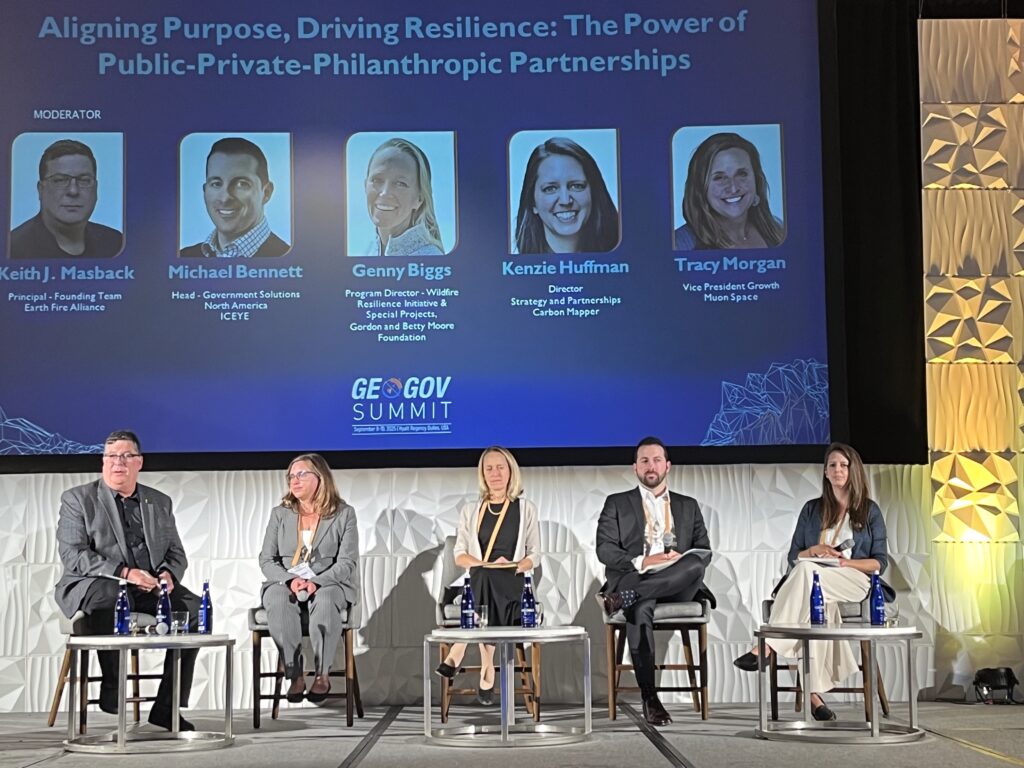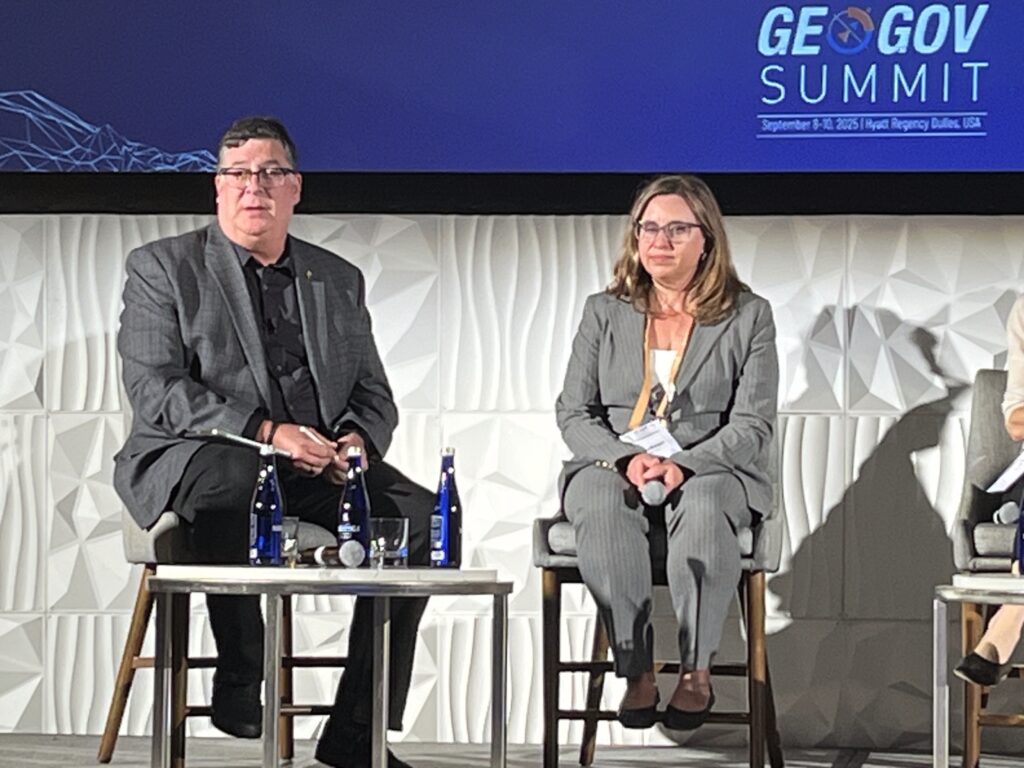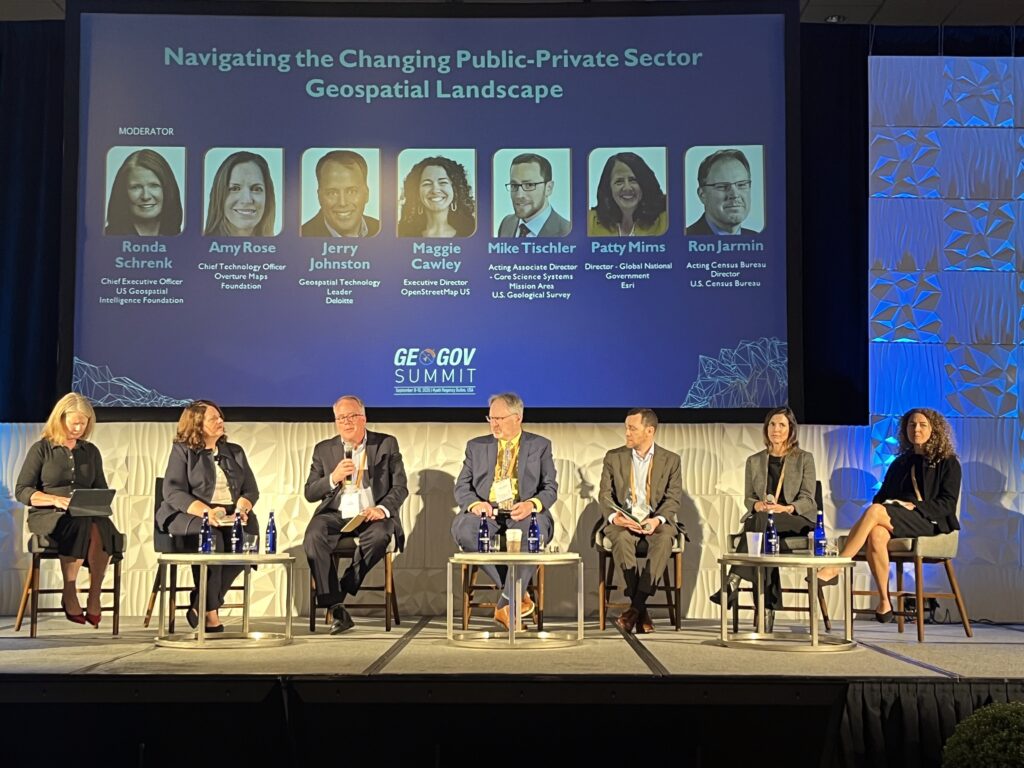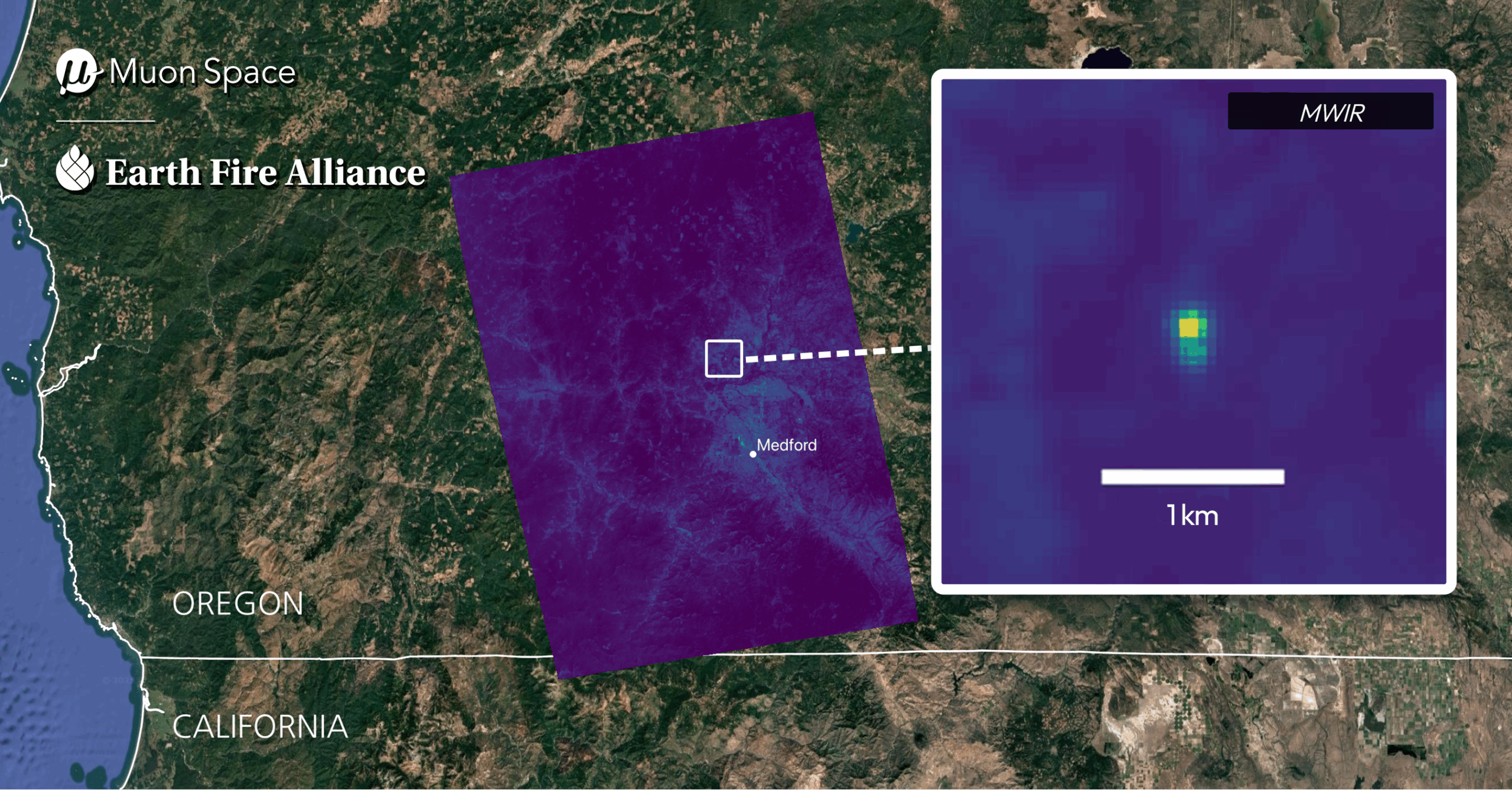By: Dawn Zoldi
This article draws insights from two dynamic plenary panels at the recent GeoGov25 Summit held in Washington, DC, where leaders across government, industry, philanthropy and the nonprofit sector gathered to confront geospatial challenges head-on. Showcasing the FireSat model and P4 (public, private, philanthropic partnerships), the sessions featured forward-looking exchanges among the leaders shaping the future of wildfire resilience through geospatial data collaboration. As the panels provided firsthand the lessons, victories and ongoing complexities of these cross-sector alliances, they also illuminated a powerful path forward for geospatial intelligence and disaster management, as well as other sectors that seek to innovate their big ideas, in the United States…and beyond.

Uniting Public, Private and Philanthropic Forces Against Wildfires
Wildfires continue to surge with increasing ferocity across the globe. This challenge demands a coalition broader than government action or commercial innovation alone. Enter the P4—public, private, philanthropic partnership—model, which draws together the strengths of each sector to solve complex problems that none could tackle on their own.
The FireSat program led by the nonprofit Earth Fire Alliance (EFA) offers a compelling case study for how multi-sector collaboration accelerates solutions and delivers real results for disaster management. As wildfires increasingly threaten lives, ecosystems, and economies, FireSat’s model, which is already inspiring similar partnerships across the geospatial, insurance and science communities, offers a blueprint for future progress.
Wildfires Demand Collaboration, Not Competition
According to Keith Masback, a founding principal of the EFA, the organization and its partners are launching a constellation of satellites purpose-built for wildfire. To do this, it first launched a robust collaboration to create lasting infrastructure for wildfire detection and response.
EFA has built a model in which its partners and funders—including the Environmental Defense Fund, Google, the Gordon and Betty Moore Foundation, and Muon Space—have built a model in which each participant assumes a role that aligns with their strengths, philanthropy de-risks early investment and innovation, and public entities ensure sustained growth.

“We’re building an alliance that has room for everybody, to include those who are for profit. We’re not intending to compete with them. We want to work together… we should be addressing the global wildfire challenge together,” Masback emphasized. This vision of partnership welcomes both data exchange and shared risk.
FireSat’s P4 Model: Philanthropy as the Key Lever
The FireSat model spotlights philanthropy as the catalyst that turns ambitious plans into real-world infrastructure.
Tracy Morgan, Vice President of Growth at Muon Space, which built FireSat, explained, “For us, it’s been great to have the philanthropic partnership to fund this early stage because… there’s not a market that allows you to just build a technology like FireSat with private funds at this point. And it’s such a critical mission.”
Morgan credits collaboration among Muon Space, EFA, Google Research, and EDF for accelerating the launch of wildfire-focused satellites. Muon Space provides the technical space infrastructure expertise, Google Research brings the AI-driven data analytics infrastructure, and philanthropic partners like Google.org and the Moore Foundation close funding gaps that initially stifle pure for-profit approaches.
Genny Biggs, Program Director at the Moore Foundation, brought home why philanthropic involvement is so critical. “When we invest philanthropically, we’re always thinking about the conditions for exit in the long run… so there’s a durable solution. [Moore Foundation namesake] Gordon Moore wanted to win in the environmental arena instead of just losing more slowly and… to take on some of the risk that public agencies or the private sector might not be able to do just because of electoral cycles, quarterly reports, whatever it is.”
By underwriting demonstration projects, the Moore Foundation and its peers enable organizations like EFA to rapidly innovate and iterate, gather critical data, and earn end user confidence, without the time pressure or risk profile that would deter commercial investors.
Lessons in Governance, Trust and Flexibility
Although wildfires are hyper-local phenomena, the infrastructure to detect, monitor and respond must operate globally. And building effective P4 coalitions means more than passing funds or sharing data. It demands relentless governance, constant alignment and a “mission-first” mentality.
The governance challenge includes juggling nonprofit requirements, corporate responsibilities and agency constraints, all while staying focused on user needs. Masback noted, “We have relationships at this point with a number of early adopters globally… each have their own governance structures and concerns… It is a really important balancing act.”
Through its Early Adopter Program, EFA is already collaborating with fire agencies across three continents—each with different funding streams. Masback explained, “Funding tends to be quite localized… the reason a purpose-built constellation for wildfire never happened, even though intuitive… there was not a business case that could immediately close, given where the dollars are arrayed.”
From Carbon Mapping to Insurance Innovations
Building effective P4 coalitions means more than passing funds or sharing data. It demands relentless governance, constant alignment and a “mission-first” mentality.
During the panel discussion, Kenzie Huffman of nonprofit Carbon Mapper echoed the importance of shared purpose: “The heart of it was philanthropy… That was a huge opportunity for us to scale and grow this constellation and also start to deliver some actionable data that is accessible to a lot of different decision makers.”
Mike Bennett of radar-based Earth observation company ICEYE described a partnership driven by donor capital that piloted parametric insurance for low- and middle-income New Yorkers: “If there was a flood… it would trigger a payment and they would automatically get funds to be able to recover more successfully. The challenge is, after two years, when you’re trying to insure for a ten-year flood event… donor capital gets impatient.”
Patience and clear benchmarks become essential, especially with philanthropic partners seeking not just to start projects but to transfer or spin them into sustainable public funding and private products.
Navigating the Broader Geospatial Landscape
These examples come against a backdrop of a rapidly changing geospatial field. Conversations moderated by USGIF’s Ronda Schrenk underscored how P4 lessons apply broadly: aligning acquisition models, lowering data access barriers and fostering interoperability between authoritative (government), crowd-sourced and commercial data.

Amy Rose of the Overture Maps Foundation noted that true partnership means “co-investment, co-design and shared governance.” These principles resonate in efforts like Overture’s, OpenStreetMap U.S., USGS and Esri, with the same ethos that underpins programs like FireSat.
Ron Jarmin, Acting Director of the Census Bureau, highlighted the need to “align incentives across the public [and] private sector to make sure we’re all swimming in the same direction in terms of how we make some of these assets… widely available.” The interplay of incentives, communication norms and public good missions threads through every successful P4 effort.
Ten Essential Tips for Effective P4 Partnerships
Drawing from the FireSat model and the voices from both plenaries, here are ten actionable lessons for leaders looking to build robust P4 models:
1. Start with a Meaningful Problem
Choose a mission where all sectors see clear value and urgency. Huffman advised, “It always comes down to sustainability… are you filling gaps to sustain a sustainable business model?”
2. Leverage Philanthropy to De-Risk Early Moves
Philanthropic capital bridges the ‘valley of death’ before public or private funding can justify commercial investment or policy change.
3. Practice Radical Collaboration
“Our globe is on fire, there’s more than too much to do, and therefore, we should be doing it together, thus, the notion of the Earth Fire Alliance,” Masback stressed. Welcome diverse perspectives, including those with whom you traditionally compete.
4. Institutionalize Governance Without Smothering Agility
Balance process with flexibility. Regular check-ins, documented best practices and living agreements help adapt to changing leadership and shifting conditions.
5. Communicate Openly and Frequently
Recognize that different partners have unique vocabularies, incentives and approval processes. Prioritize transparency and patience.
6. Design for Exit and Long-Term Sustainment
Philanthropy succeeds when investments transition to public or commercial support. “We’re always thinking about the conditions for exit in the long run… structuring things so there’s a durable solution,” said Biggs.
7. Focus on Impact, Not Just Technology
Tools and satellites matter only if they meet end user needs and drive measurable improvements. EFA’s structure brings fire agencies and fire scientists into early feedback loops.
8. Align Incentives Early and Revisit Often
Assume incentives will evolve, both internally and externally. “Where you sacrifice along the way is actually one of the challenges,” noted Huffman.
9. Demonstrate Success and Share Lessons
Openness inspires others. “Help us get the word out about success stories,” encouraged Bennett. Use tangible results to build a culture of replication and scale.
10. Invest in Human Relationships and Education
Ultimately, trust—built through mutual effort, shared wins and transparency—keeps P4 projects alive. Schrenk urged, “Getting out of your office, your space and coming and meeting with each other… helps us to build trust.”
The Future of P4: Building Capacity for New Challenges
As climate change and natural disasters intensify, the need for robust, multi-sector partnerships grows. The P4 model demonstrates how combining public mission, private innovation,and philanthropic flexibility can create durable fields of action, not just demonstration projects. Schrenk challenged the geospatial community to remain agile and collaborative, emphasizing people as the real drivers of change.
Real progress, as the panelists repeatedly affirmed, comes not from grand declarations but from patient work and civic-minded investment. For leaders in geospatial intelligence, wildfire management, disaster recovery and beyond, the P4 model can turn high-stakes problems into shared victories and light a path for the future generations of partners in any field.

